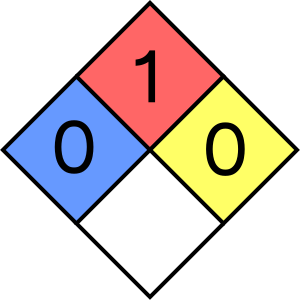GLUCOSE (D-GLUCOSE)
Basic information
- Chemical formula(s): \({\rm C_6H_{12}O_6}\)
- Other names: D-glucose, dextrose, grape sugar, blood sugar, corn sugar
- CAS number: 50-99-7
- EC number: 200-075-1
- Molecular weight: 180.2 g/mol
- International Chemical Safety Card (ICSC): ICSC 0865
- Flammability: yes (combustible)
- Description: White crystalline powder with sweet taste. Highly soluble in water. Natural sugar found in fruits, honey, and blood. Generally recognized as safe (GRAS) food ingredient.
NFPA 704 (fire diamond)

- Health (blue): 0 - poses no health hazard.
- Flammability (red): 1 - must be pre-heated before ignition can occur under typical fire conditions.
- Instability–reactivity (yellow): 0 - normally stable, even under fire exposure conditions, and is not reactive with water.
- Special notice (white): -
Hazard statements
Glucose is not classified as hazardous under GHS regulations. However, as a combustible organic powder, certain precautions apply:
| Code | Phrase |
|---|---|
| - | No hazard statements assigned (not classified as hazardous) |
Precautionary statements
Despite not being classified as hazardous, the following precautionary measures apply for combustible powders:
| Code | Phrase |
|---|---|
| P280 | wear protective gloves/protective clothing/eye protection/face protection |
| P370+P378 | in case of fire: use water spray, foam, dry powder, carbon dioxide for extinction |
| P420 | store separately from incompatible materials |
Protective measures
Gloves
For routine handling of glucose powder:
- Any standard laboratory gloves: very good - glucose is non-toxic and non-irritating.
- Nitrile: very good - prevents contamination and provides grip.
- Natural latex or rubber: very good - adequate for normal handling.
- Vinyl: very good - suitable for food-grade handling.
Safety goggles
- Standard safety glasses recommended when handling large quantities to prevent eye irritation from dust.
- Not required for small quantities but good laboratory practice.
- Corrective glasses are not considered safety goggles.
Clothing
- Standard laboratory clothing is sufficient.
- Long sleeves recommended when handling large quantities to minimize skin contact with dust.
- Closed-toe shoes required as standard laboratory safety.
- No special protective clothing required.
Respiratory protection
- Dust mask recommended when handling large quantities or in poorly ventilated areas.
- Minimize dust generation during handling.
- Ensure adequate ventilation to prevent dust accumulation.
- Dust explosion hazard: Prevent accumulation of airborne dust in confined spaces.
Spill management
- Sweep up material carefully to minimize dust generation.
- Use non-sparking tools and avoid creating dust clouds.
- Fire prevention: Eliminate ignition sources during cleanup.
- Collect in appropriate container - can be disposed as non-hazardous waste.
- Clean area with damp cloth to remove residual dust.
- Ensure good ventilation during cleanup.
- No special disposal requirements - food-grade material.
Special warnings
- Combustible powder - finely dispersed particles can form explosive mixtures in air.
- Dust explosion hazard - prevent accumulation of dust in confined spaces.
- Reacts violently with strong oxidants - store separately from oxidizing agents.
- Generally recognized as safe (GRAS) - approved food ingredient with very low toxicity.
- Diabetic considerations - large ingestion will raise blood glucose levels.
- Store in cool, dry place in tightly closed containers.
- Hygroscopic - absorbs moisture from air, may cake if stored improperly.
- Keep away from heat sources and ignition sources.
- Use closed systems and dust explosion-proof electrical equipment when handling large quantities.
- No open flames during handling of powder.